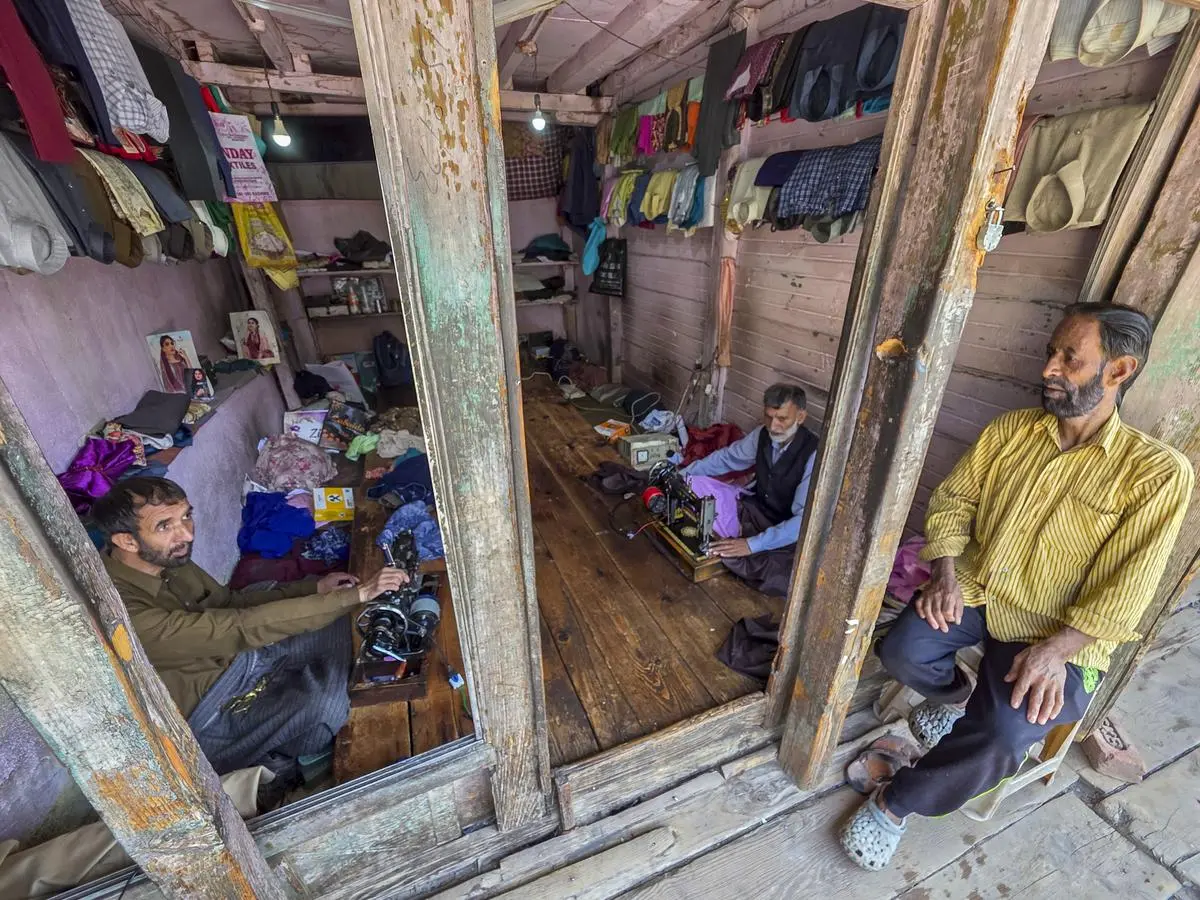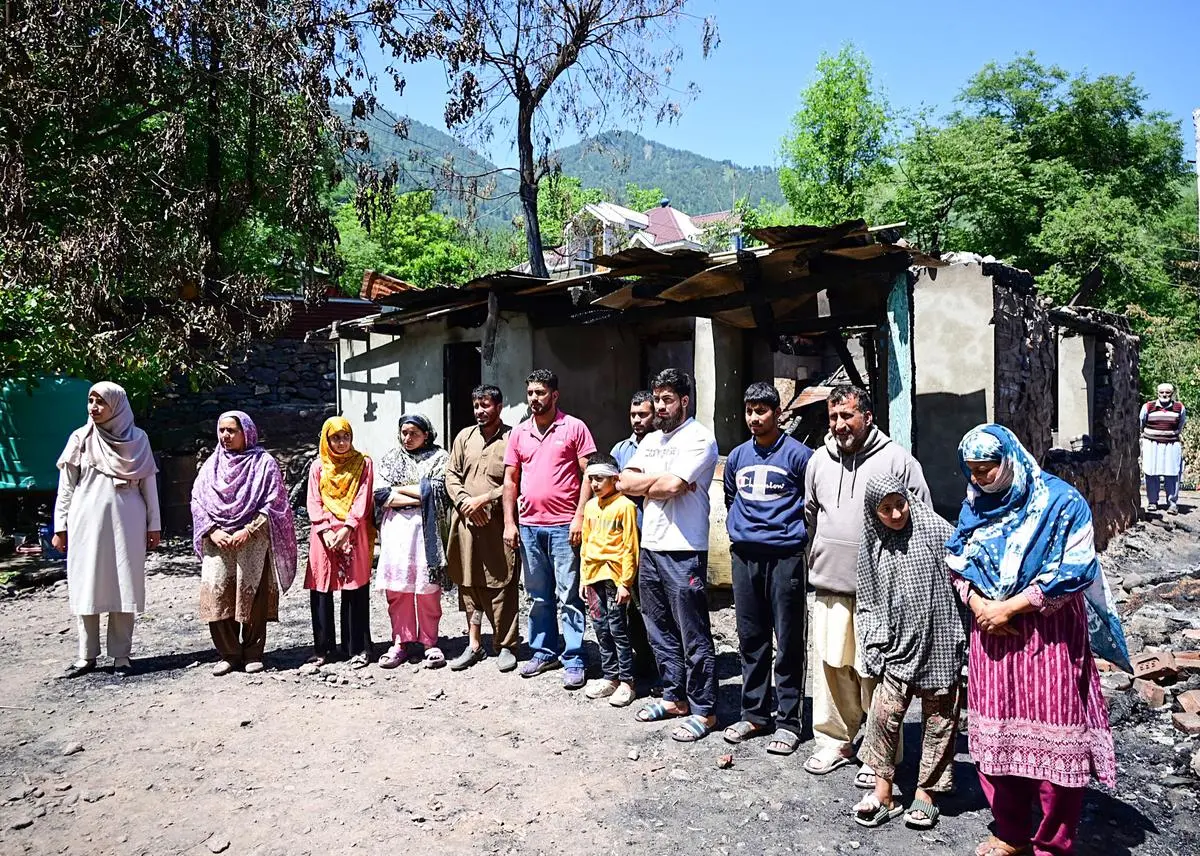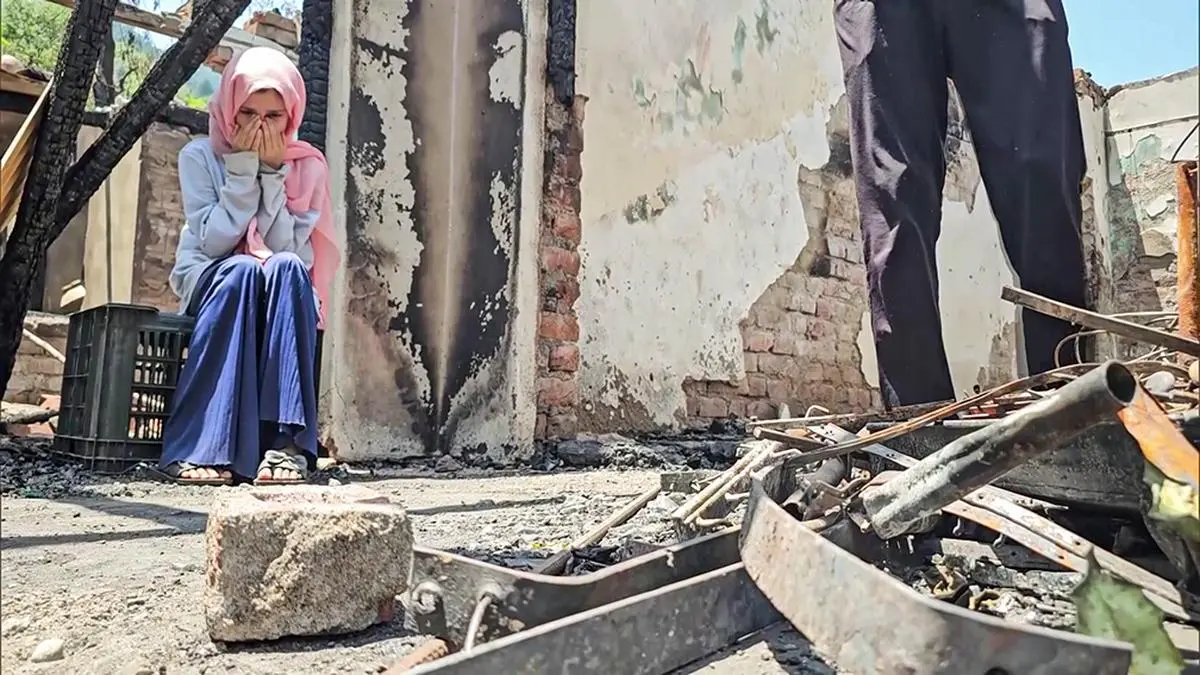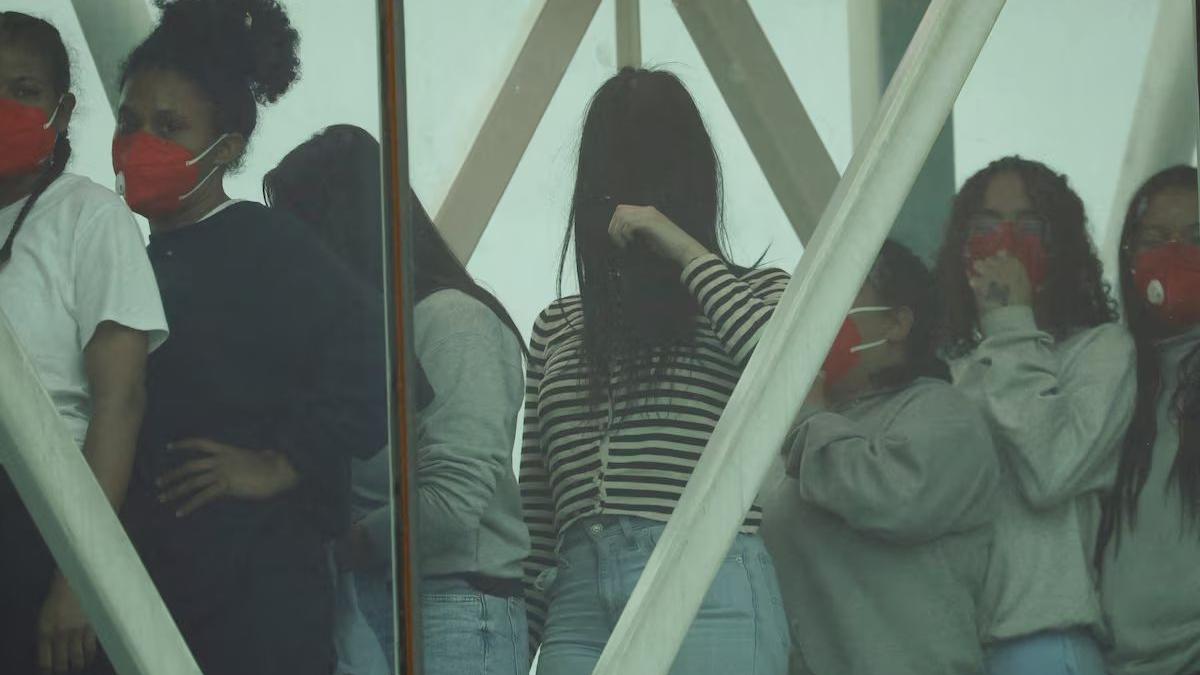Jaleel Mir, a farmer in his early 60s, thought he would have a heart attack when the loud explosions went off on the intervening night of May 7 and 8. The Mir family hails from Gantamulla Bala, a north Kashmir village in Uri, not far from the Line of Control (LoC). According to Mir, after total darkness, the night sky suddenly lit up with artillery fire. “Hamein laga jaise qayamat aagai (We felt as if doomsday had arrived),” Mir told Frontline. “We were terrified. The women and children were crying in panic. We thought we would all die.”
Mir and other eyewitnesses talk of the deafening noise caused by the relentless mortar shells, the artillery fire, and the drones flying overhead. For people like Mir, living on the LoC, life is often uncertain and unpredictable. Mir’s family was fortunate to survive the skirmish between India and Pakistan. But not everyone did.
Nargis Bashir Bano, 45, was rushing to take refuge. Her plan was to reach Baramulla, a big town roughly 45 km from Uri, which is considered relatively safer. But it was not to be. An artillery shell hit the SUV car in which she and her family were travelling. The hit came near Mohurra, about 3 km from Rajarwar, another village near Uri. Bano did not survive. It was May 8, a Thursday.
As Bano breathed her last on her way to Government Medical College in Baramulla, this is all her inconsolable daughter could say: “We’ve never seen anything like this before.” Bano became Kashmir’s first civilian casualty in the latest battle.
Under ideal circumstances, Uri is about a three-hour drive from Srinagar, the summer capital of Jammu and Kashmir. But the ongoing road expansion work on the highway, the convoy movements, and the multiple security checkpoints make it a much longer drive that is only a shade over 100 km. Frontline visited Uri twice in the span of a fortnight, first during the crisis and then after the two nuclear neighbours agreed to end hostilities, reportedly at the behest of the US, Iran, Saudi Arabia, and partly China.

Tailors resuming work a day after India and Pakistan reached a bilateral consensus, at Uri in Baramulla district, on May 11.
| Photo Credit:
PTI
May 7 dawned fairly peacefully, said Uri residents, but the world turned upside down the very next day. There was unprecedented escalation along the LoC with both arch rivals—India and Pakistan—intensifying artillery and mortar fire and accusing the other of “provocation” and subsequently acting in “self-defence” and giving an “effective response”.
Actually, this has been the story since 1947-48. But, away from the overarching narratives of the two nuclear powers, the Kashmiris who live on either side of the dividing line share similar stories of pain, division and unending ordeal, of fear and uncertainty, and of hope that someday conflicts will be resolved on the negotiating table.
After the cessation of hostilities, Mir was busy tending his farm on May 15. War, Mir said, is not good for anyone. “Baat cheet se masla hal hona chahiye (Issues should be resolved through talks),” he said, explaining that the situation was always “worse” for those living on the LoC, the line referred to as the ceasefire line until the late 1940s. He said people had fled to safety, by foot or using any transport they could afford. “Some people took shelter with their relatives who lived far from the LoC while others were accommodated in college hostels, school buildings and seminaries.” (People from Uri were brought to Shiree and Baramulla for safety and provided shelter in hostels, schools and seminaries)
Also Read | India wants war like it wants cricket: televised, choreographed, and far away
Ghulam Mohiuddin, 50, a farmer from a village in Uri tehsil, told Frontline that the situation was neither good nor normal for the residents. He added that the circumstances considered abnormal for the outside world have been made normal for the people here who bear the brunt of the violence. Children here are raised under very difficult circumstances, he said.
Mohiuddin added that “everyone rushed out of their homes in panic on hearing the sounds of heavy shelling and explosions. We thought the shells were hitting our homes”. The visibly angry farmer from Gantamulla Bala had a word of caution for the Noida-based television anchors. “The cost of war is known only by the ones whose houses are destroyed in shelling and those who lose their loved ones. Those sitting in their comfortable studios will never know, never understand,” he told Frontline.
Now that the brief spell of post-ceasefire shelling has stopped, both Mir and Mohiuddin have returned to their farms after more than a week. “Today, it feels much better. There was great fear among us. We stayed indoors, in complete blackout. Thankfully, from today we can step out,” said a young farmer from Uri, adding, “In war, only innocent lives from either side are lost. We want peace, dialogue and resolution. War is not a solution.”
There were two contrasting visuals from Uri last fortnight. When Frontline visited the area on May 8, some injured people were being moved to the hospital in Baramulla while residents were fleeing Uri in panic and taking shelter in nearby places.
Highlights
- During his tour to some of the affected areas in north Kashmir, Chief Minister Omar Abdullah told reporters that more individual and community bunkers would be erected in districts close to the LoC.
- Abdullah reaffirmed his government’s commitment to the welfare of the people who live along the LoC.
- Former Chief Minister and President People’s Democratic Party (PDP) Mehbooba Mufti also visited the affected areas.
By the time of the second visit, however, educational institutions had opened and farmers in areas such as Baramulla, Shiree, Gantamulla Bala, Kamalkote, Madhan, Gowhallan, Lagama, Bijhama, Gangerhill, Gawalta, among others were allowed to return to their fields after getting due clearance from the district administration.
After the ceasefire, in the third week of May, when Frontline reached Baramulla town, about 55km from Srinagar, the degree college was open. There was an uneasy calm, although fear was still palpable. Students spoke about their academic calendar, dreams, aspirations, dialogue, resolution, peace, and hope.
Some expressed delight over “the ceasefire brokered by the US”, arguing that current and previous generations in Kashmir have “suffered enough” and deserve a “dignified life”.
“Our multiple generations have suffered because of the ongoing conflict. Our academic cycles were terrible in 2016 and 2019. We have decided that we want peace and don’t want conflict. We want both countries [India and Pakistan] to settle their differences through dialogue, not war,” said an undergraduate in Baramulla.
The student was disappointed over what he called the “stereotyped misrepresentation” of Kashmiri youngsters by television news channels based in New Delhi and Noida. “We have always been misrepresented and stereotyped. These television journalists do not follow the ethics of journalism.”
He spoke of the stress to local people during the missile and drone attacks. “It was a terrible situation for us. We don’t want anyone to go to prison or get killed. We are peaceful people who want to live in harmony; we want an end to war and hostility.”
Aquib, a 22-year-old journalism student, said that if he were to be truthful he would say that fear still exists. “You never know what will happen next. People from Uri had to leave their homes and take shelter in Baramulla. Since childhood I have experienced such uncertainty,” he said, adding that even as the college had resumed, cycles of uneasy calm and violence keep repeating in Kashmir.
Aquib is not off the mark. The unresolved conflict and continued cycles of violence have inflicted profound trauma on the Kashmiris. A research study (2015) conducted by the Paris-based Medicins Sans Frontieres or Doctors Without Borders in collaboration with the Institute of Mental Health and Neurosciences (Kashmir) in 10 districts of Kashmir Valley found that “nearly 1.8 million adults (45 per cent of the adult population) in the Valley are experiencing symptoms of mental distress, with 41 per cent exhibiting signs of probable depression, 26 per cent probable anxiety and 19 per cent probable Post Traumatic Stress Disorder”. In 2015, the Kashmir Mental Health Survey was conducted “to estimate the prevalence of mental health-related conditions, specifically depression, anxiety and post traumatic stress disorder symptoms in Kashmir and to determine the accessibility to mental health services.”
Meanwhile, according to the students in Baramulla, their college was among the first to be impacted by the India-Pakistan conflict. “The affected people from the LoC villages were brought to our college for temporary shelter. So, our institute was closed,” said one student.

Kashmiri people affected by Pakistani shelling gathered ahead of the visit of Jammu and Kashmir Chief Minister Omar Abdullah, at Uri in Baramulla, on May 14.
| Photo Credit:
ANI
When Frontline visited north Kashmir again on May 15, shops and educational institutions had partially opened in Baramulla town; but in the villages near Uri, schools and other institutions remained shut, awaiting clearance from the authorities.
Apart from Uri, mortar shelling was also reported in areas such as Dolipora, Chowkibal and Kralpora in north Kashmir’s Kupwara district. Many people were wounded and multiple houses were reduced to rubble. For the families, everything was destroyed, except for the memories of their ordeal. Some people lost not just their homes, but also hopes of a solution.
During his tour to some of the affected areas in north Kashmir, Chief Minister Omar Abdullah told reporters that more individual and community bunkers would be erected in districts close to the LoC. “Thankfully, the ceasefire is holding, and we are working diligently to assess damage and extend help wherever required. We will draft a policy for more individual underground bunkers in vulnerable areas near the LoC,” he said.
Abdullah reaffirmed his government’s commitment to the welfare of the people who live along the LoC. Accompanied by Nasir Aslam Wani, his advisor, Abdullah visited areas such as Salamabad, Lagama, Bandi, Razarwani, and Gingal. “It is the responsibility of my government to ensure you receive support to rebuild your lives with dignity,” he said.
Several MLAs also toured their respective constituencies to assess the damage caused to homes near the LoC. Former Chief Minister and President People’s Democratic Party (PDP) Mehbooba Mufti also visited the affected areas. Jammu and Kashmir Lieutenant Governor Manoj Sinha visited Kupwara. In the Tangdhar sector, Sinha told residents that his administration was “working on a comprehensive plan” to ensure rehabilitation of the affected residents.
In the Poonch town of Pir Panchal range in Jammu, according to official statistics, at least 13 civilians were killed on the intervening night of May 7 and 8 in “heavy shelling from Pakistani armed forces”. Three more civilians, including an administrative officer, were killed a day later as a result of long-range mortar firing in neighbouring Rajouri. The overall death toll in the face-off along the LoC is reportedly close to 24 at this point.
Geopolitical security and strategic experts warn of the fragility of the narrative of peace in Kashmir. C. Christine Fair, a professor at Georgetown University’s security studies programme in the Edmund A. Walsh School of Foreign Service, has argued in her latest piece in Foreign Policy that the Pakistani leadership will continue to take risks for Kashmir.
Also Read | The war has paused—will peace get a word in?
“The dust has yet to settle on the most recent Pakistan-India crisis, but another one is already—and inevitably—around the corner within the next few years. The Pakistani Army, which rules the country, sees the conflict over Kashmir as existentially critical for the nation, regardless of material considerations. The latest conflict, meanwhile, has reinforced the assessment by the Pakistani leadership that asymmetric warfare works, however risky it may be,” the American security expert wrote.
While the governments, armies, and analysts make security and strategic assessments and regardless of the competing media narratives, Jaleel Mir does not want to experience another horror. His family is not willing to pay the cost of the unending conflict. And Nargis Bashir Bano did not even live to see the fragile ceasefire play out in Kashmir. It is most often ordinary Kashmiris like Mir and Bano who suffer the most and that is perhaps why they abhor violence and war and favour dialogue and peace.
“Khouf ke saye main baar baar marne se acha hai ek hi baar masla hal karo, aar ya par (It is better to resolve the issue once and for all than keep dying in the shadow of fear),” said Mir.
Gowhar Geelani is a senior journalist and author of Kashmir: Rage and Reason.



